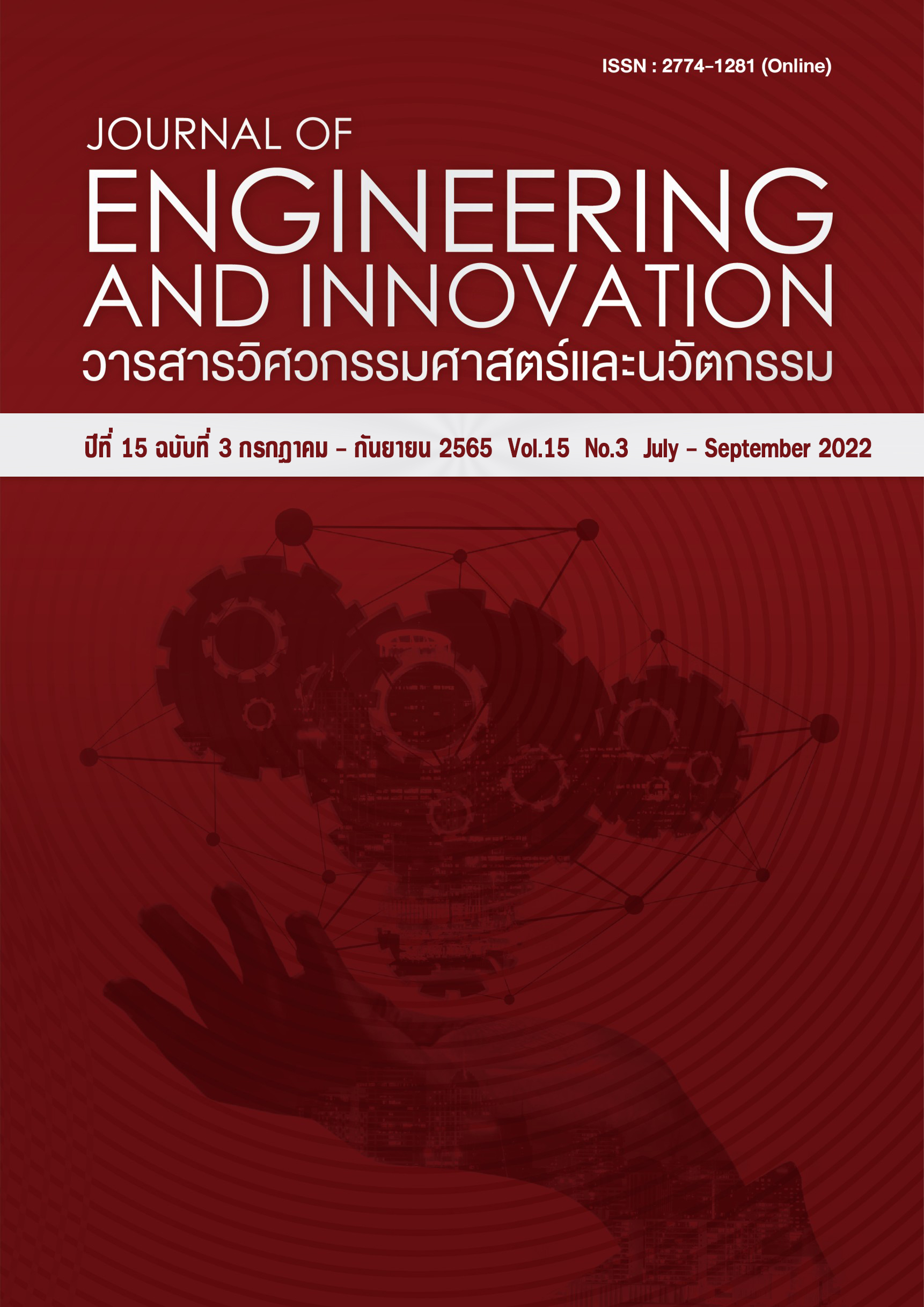Determining the significance of installation parameters affecting energy yield of grid-connected rooftop photovoltaic system
Main Article Content
Abstract
The performance of grid-connected rooftop photovoltaic system relies mainly on installation parameters including orientation, tilt angle of PV panel, technologies of photovoltaic modules and power converter configuration. However, due to many technical issues, it is difficult to define all parameters at their optimal conditions in order to maximize system yields. This paper aims to investigate the impact of parameters on system yields using the design of experiments following Taguchi approach. The energy production for each experiment is assessed by PVsyst 7.2 and then signal-to-noise (S/N) analysis together with analysis of variance (ANOVA) is performed. The final analysis indicates that the orientation of PV panel and the tilt angle is the two most significant factors affecting the system yields while the installing the optimizer and photovoltaic cell technologies have lesser impact. The analytical results well align with the data collected from example PV system sites.
Article Details
References
กระทรวงพลังงาน. แผนพัฒนากำลังผลิตไฟฟ้าของประเทศไทย พ.ศ. 2561 – 2580 ฉบับปรับปรุงครั้งที่ 1. Available from: http://www.eppo.go.th/ images/ Infromation_service/public_relations/PDP2018/PDP2018Rev1.pdf [Accessed 28th May 2021].
Dey D, Subudhi B. Design, simulation and economic evaluation of 90 kW grid connected Photovoltaic system. Energy Reports. 2020; 6: 1778-1787.
Kumar N, Kumar M, Rejoice P, Mathew M. Performance analysis of 100 kWp grid connected Si-poly photovoltaic system using PVsyst simulation tool. Energy Procedia. 2017; 117: 180-189.
Behura AK, Kumar A, Rajak DK, Pruncu C, Lamberti L. Towards better performances for a novel rooftop solar PV system. Solar Energy. 2021; 216: 518-529.
Bari S. Optimum slope angle and orientation of solar collectors for different periods of possible utilization. Energy Conversion and Management. 2000; 41: 855–860.
Bairi A. Method of quick determination of the angle of slope and the orientation of solar collectors without a sun tracking system. Solar& Wind Technology. 1990; 7(2-3): 327–330.
Kaldellis J, Kavadias K, Zafirakis D, Experimental validation of the optimum photovoltaic panels’ tilt angle for remote consumers. Renewable Energy. 2012; 46: 179-191.
Siraki AG, Pillay P. Study of optimum tilt angles for solar panels in different latitudes for urban applications. Solar Energy. 2012; 86(6): 1920-1928.
Li C. Comparative performance analysis of grid-connected PV power systems with different PV technologies in the hot summer and cold winter zone. International Journal of Photoenergy. 2018; 2018: 1-9.
Ozden T, Akinoglu B, Turan R. Long term outdoor performances of three different on-grid PV arrays in central Anatolia – An extended analysis. Renewable Energy. 2017;101:182-195.
Sharma V, Kumar A, Sastry O, Chandel S. Performance assessment of different solar photovoltaic technologies under similar outdoor conditions. Energy. 2013; 58: 511-518.
Kesler S, Kivrak S, Dincer F, Rustemli S, Karaaslan M, Unal E et al. The analysis of PV power potential and system installation in Manavgat, Turkey—A case study in winter season. Renewable and Sustainable Energy Reviews. 2014; 31: 671-680.
Hosseinzadeh M, Salari A, Sardarabadi M, Passandideh-Fard M. Optimization and parametric analysis of a nanofluid based photovoltaic thermal system: 3D numerical model with experimental validation. Energy Conversion and Management. 2018; 160: 93-108.
Sivasakthivel T, Murugesan K, Thomas HR. Optimization of operating parameters of ground source heat pump system for space heating and cooling by Taguchi method and utility concept. Applied Energy. 2014; 116: 76-85.
Kazem H, Khatib T, Sopian K, Elmenreich W. Performance and feasibility assessment of a 1.4kW roof top grid-connected photovoltaic power system under desertic weather conditions. Energy and Buildings. 2014; 82: 123-129.
Hailu G, Fung AS. Optimum tilt angle and orientation of photovoltaic thermal system for application in Greater Toronto area, Canada. Sustainability. 2019; 11(22): 6443.
Tsalides P, Thanailakis A. Direct computation of the array optimum tilt angle in constant-tilt photovoltaic systems. Solar Cells. 1985; 14(1): 83-94.
Magare DB, Sastry OS, Gupta R, Betts TR, Gottschalg R, Kumar A, et al. Effect of seasonal spectral variations on performance of three different photovoltaic technologies in India. International Journal of Energy and Environmental Engineering. 2016; 7: 93–103.
Kaldellis J, Kavadias K, Zafirakis D. Experimental validation of the optimum photovoltaic panels' tilt angle for remote consumers. Renewable Energy. 2012; 46: 179-191.
Kadri R, Gaubert J, Champenois G. New converter topology to improve performance of photovoltaic power generation system under shading conditions. In: IEEE: Proceeding of the International Conference on Power Engineering, Energy and Electrical Drives, 11-13 May 2011, Malaga. Spain: p.1-7.
Blaabjerg F, Chen Z, Kjaer SB. Power electronics as efficient interface in dispersed power generation systems, IEEE Transactions on Power Electronics. 2004; 19(5): 1184-1194.
Thevenard D, Driesse A, Pelland S, Turcotte D, Poissant Y. Uncertainty in long-term photovoltaic yield predictions. Natural Resources Canada, Canmet Energy. 2010; Report number: 2010-122. Available from: https://www.nrcan.gc.ca/sites/www.nrcan.gc.ca/files/canmetenergy/files/pubs/2010-122.pdf [Accessed 28th May 2021].
Dhimish M, Alrashidi A. Photovoltaic degradation rate affected by different weather conditions: a case study based on PV systems in the UK and Australia. Electronics. 2020; 9(4): 650.
Osterwald CR, McMahon TJ, del Cueto JA, Electrochemical corrosion of SnO2:F transparent conducting layers in thin-film photovoltaic modules, Solar Energy Materials and Solar Cells. 2003; 79(1): 21-33.

